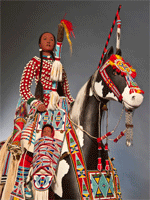Navajo weavers have been famous for their spectacular blankets and rugs for centuries. From the appropriation of Pueblo looms and sheep from Spanish colonists to the establishment of trading posts by Anglo settlers, Navajo textiles reflect the experiences of this resilient people among their neighbors in the American Southwest.
Originally created for utilitarian purposes, these pieces are now regarded as woven art that embodies a unique aesthetic with enduring appeal. Showcasing stunning weavings, textile historian Cecilia Anderson highlights the origins and history of the Navajo weaving tradition and the signature designs and colorful techniques that distinguish these iconic textiles. Anderson is on the faculty of the Smithsonian–George Mason University MA in the History of Decorative Arts program.
Other Connections:
To learn more about the traditions of the Navajo, listen to clips from Smithsonian Folkways>>
You May Also Enjoy:
 Grand Procession: Dolls from the Charles
Grand Procession: Dolls from the Charles
and Valerie Diker Collection
Apr. 17, 2013–Jan. 5, 2014
National Museum of the American Indian
Grand Procession celebrates Native identity through 23 colorful and meticulously detailed objects that are much more than dolls. Traditionally made by female relatives using buffalo hair, hide, porcupine quills, and shells, figures like these have long served as both toys and teaching tools for American Indian communities. Outfitted in intricate regalia, these dolls—on loan from the Charles and Valerie Diker Collection—represent Plains and Plateau tribes and the work of five artists. Their superb craftsmanship and attention to detail imbue these figures with a remarkable presence and power, turning a centuries-old tradition into a contemporary art form. Learn more>>